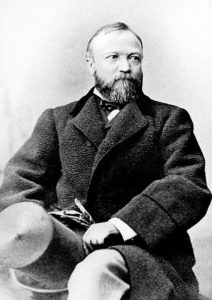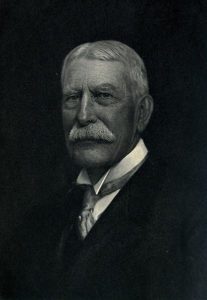Entrepreneur
John Steele Gordon Author, An Empire of Wealth: The Epic History of American Economic Power
The word “entrepreneur”—one who undertakes, manages, and assumes the risk of a new enterprise—comes from the French, where it literally means “undertaker.” The word was borrowed into English in the mid-19th century—perhaps the golden age of the entrepreneur—when the number of new economic niches was exploding and the hand of government was at its lightest in history. The activity of entrepreneurship, of course, is much older, going back to ancient times. As for America, entrepreneurs founded our nation.
In 1607 the Virginia Company sent three ships across the Atlantic and unloaded 109 passengers at what became Jamestown, Virginia. They were embarked on a new business enterprise that they hoped would be profitable—American plantations. The Virginia Company was a joint-stock company, a relatively new invention that allowed people to invest in enterprises without running the risk of losing everything if the business did not succeed. By limiting liability, corporations greatly increased the number of people who could dare to become entrepreneurs by pooling their resources while avoiding the possibility of ruin. Thus the corporation was one of the great inventions of the Renaissance, along with printing, double-entry bookkeeping, and the full-rigged ship.

John Rolfe and Pocohontas
Allowing incorporation as a matter of law, rather than requiring an act of the executive or of the legislature, began in the United States as early as 1811, when New York State passed a general incorporation law for certain businesses, including anchor makers. Soon enlarged in scope, the ability to incorporate simply by filling out the right forms freed the process from politics. There had been only seven companies incorporated in British North America, but the state of Pennsylvania alone incorporated more than 2,000 between 1800 and 1860.
Unfortunately for the stockholders of the Virginia Company, the business of American plantations was a very new one and had a steep learning curve—a curve all would-be entrepreneurs must climb to be successful. The Virginia Company made just about every mistake that it could make: It tried to run Jamestown as a company town; it searched for gold, of which Virginia has none, instead of planting crops; and it failed at establishing a glass-making industry. Eventually Jamestown was nearly abandoned. Only when John Rolfe introduced West Indian tobacco in 1612 did Virginia find an export that had a market in Europe and made Virginia rich. But by that time it was far too late for the Virginia Company, which went broke.
“In fact, of course, most entrepreneurs do fail.”
It has not been nearly well enough noted that the American colonies, while many ended up in royal hands, were not founded by the English state. Profit-seeking corporations founded several, such as Massachusetts Bay, Plymouth, and Virginia. Proprietors founded others, such as Pennsylvania and Maryland. To be sure, many of these enterprises had non-entrepreneurial motives, such as providing a refuge for religious dissenters. John Winthrop wanted the Puritans to establish a “shining city on a hill”; William Penn thought of Pennsylvania as a “Holy Experiment” where Quakers could live in peace. But Plymouth, Massachusetts Bay, and Pennsylvania were also expected to show a profit. “Though I desire to extend religious freedom,” said Penn, “yet I want some recompense for my troubles.”
The Dutch, not the English, of course, founded New York, and profit was the sole reason for settling on Manhattan. Even after the British took the colony in 1664, the Dutch devotion to commerce remained. Harking back to the early source of its economic success, the fur trade, the city’s seal remains a beaver surrounded by wampum.
In the theocracy that was early New England, the entrepreneurial spirit burned bright. Unlike the colonies on the Chesapeake, there was no cash crop that could be grown in New England’s stony soil and short growing season. Perhaps the closest thing to a cash crop was that singular beast, the Atlantic cod. Pulled from the great fishing waters off New England in prodigious numbers, it was salted, dried, and shipped to Europe to provide cheap protein for the masses. Even today, there is a carving of a codfish hanging in the Massachusetts State House. Perhaps because New England lacked a true cash crop, its economy became much more diverse than those of the Southern colonies. Shipping and shipbuilding lumber, fishing, slaving and rum distilling became mainstays of the New England economy and produced its earliest fortunes.
Also very important to the evolving New England economy was iron, a commodity that had by then been indispensable for 3,000 years. At first this iron had to be imported at vast expense from foundries in England. John Winthrop the younger saw opportunity and seized it. There was plenty of iron ore available, but to make iron he needed something America did not then have—capital. So he sailed to England in 1641 to get it. Why, one might well wonder, would English capitalists invest in a major industrial enterprise located in a wilderness 3,000 miles away? The answer lay in something America did have in indescribable abundance—wood. Charcoal was as indispensable as ore to iron smelting, and whereas England’s forests were being rapidly cut down, America had well over a million square miles of forest. So Winthrop was able to argue that combining America’s cheap raw materials with England’s capital would produce a product that could be sold at a profit, not only in Massachusetts but in England as well.

Andrew Carnegie
Winthrop called the new company the Company of Undertakers—note the word, the literal translation of “entrepreneur”—to which the government of Massachusetts granted a 21-year monopoly on iron production, an exemption from taxation, and the right to export iron once local demand was met. (Obviously, cozy relations between government and industry are not wholly a recent phenomenon.) The Saugus Iron Works, as it is known, was a financial failure. But it is now a national historic site for it was the start of a great American industry.
By the end of the colonial era, the colonies were producing one-seventh of the world’s pig iron. A little over 100 years later, the U.S. was producing more iron and steel than Britain and Germany combined, and producing them so efficiently that we were an exporter to those countries. Andrew Carnegie, who had arrived in America a penniless immigrant from Scotland in the 1840s, manufactured much of that iron and steel. When he sold out to J. P. Morgan in 1901, Morgan congratulated him on becoming “the richest man in the world.”
The Saugus Iron Works was contemporaneous with the beginning of one of the handmaidens of American entrepreneurship, American invention. The first patent awarded to an American resident was given to Joseph Jenks in 1646 for a device that improved the manufacture of edged tools, such as sickles. It was the beginning of the “Yankee ingenuity” that has characterized America’s economy ever since, from that first machine tool to bifocal glasses, the cotton gin, automated flour mills, the high-pressure steam engine, interchangeable parts, the McCormick reaper, the oil industry, the airplane, Coca-Cola, the affordable automobile, the digital computer, and Twitter. For an example of how great a synergistic effect entrepreneurship and invention have had on each other, consider that when Twitter went public last year, the stock offering produced no fewer than 1,600 newly-minted millionaires.

Henry Flager
By the time the 13 colonies declared independence, they were, after only 169 years, the richest place on earth per capita. No wonder the British fought so hard to suppress the rebellion.
Adam Smith’s The Wealth of Nations was published the same year as independence was declared. Being very young, America did not have the burden of hundreds of years of economic cronyism. There were no aristocrats, no guilds, no ancient monopolies or hereditary tariffs as there were in continental Europe. We had less past than any other country, and therefore we could make our own history, creating the most Smithian economy in the western world.
“Nothing encourages entrepreneurial activity more than the freedom to take risk.”
Consider one of my favorite early American entrepreneurs, Frederic Tudor. In 1806, he decided to sell ice. He wanted to get it where it was cheap, New England, and sell it where it was dear, the Southern states and the West Indies. Everyone laughed. But his secret was a waste product that a great New England industry was more than happy to supply him with for free—sawdust, an excellent insulator. So Tudor combined two cheap things and made them valuable simply by moving their location. By 1820 he was shipping 2,000 tons of ice a year to as far away as Calcutta, getting as much as 25 cents a pound. By 1850, ice was one of New England’s largest exports. By 1900, of course, the trade was dead, thanks to the invention of refrigeration. We call that creative destruction.
“A second great spur to entrepreneurship is the freedom to fail. ”
And no country in the world has been as consistently tolerant of economic failure as the United States. While bankruptcy in Europe has always been regarded as a moral as well as a financial failure, this has not been the case here—possibly because we are descendants of people who sought a second chance by immigrating. There were, to be sure, debtors prisons in colonial and early America. But debtors prison, a remarkably counter-productive institution—after all, how do you pay off your debts while you’re cooling your heels in jail?— was abandoned in the U.S. earlier than elsewhere. It ended under federal law in 1833, and most states had followed suit by 1850. Great Britain wouldn’t abolish debtors prison until 1869.
As a result of this freedom to fail without suffering social opprobrium, many entrepreneurs were able on their second or third try to strike it rich. Consider Henry Flagler, who began his business career in the wholesale commodity business and prospered so well that he was making a then vast income of about $50,000 a year by the time of the Civil War. When the war drove the price of salt through the roof, Flagler invested heavily in a salt company in Michigan. When the war ended, however, the price of salt collapsed, as did the business. Flagler, who had risen from the son of an itinerant preacher to the “one percent,” was broke. He had to borrow money from his father-in-law—at ten percent interest, no less—in order to feed and house his family. But only five years later, Flagler was a founding partner of Standard Oil, with one-sixth of the company. Later, Flagler used his Standard Oil millions to create the modern state of Florida, turning it from a semi-tropical wilderness into a tourist mecca and agricultural powerhouse.
Or consider Isaac Merritt Singer. He was on his own by the time he was 12, and only basically literate—a character straight out of Dickens. At 19 he obtained an apprenticeship in a machine shop and soon demonstrated a marked talent for mechanics. Unfortunately for Singer, he wanted to be an actor—a profession for which he had little talent. Singer tinkered on the side and invented a rock drill, but he was so desperate for money that he sold the patent for a mere $2,000. Only when he gave up acting in middle age did he turn his attention full time to mechanics, and soon after that he invented a new kind of sewing machine that had a great advantage over previous kinds: It actually worked.
A shirt that took a seamstress 14 hours to sew by hand could now be produced in an hour-and-a-quarter. Many clothing workers feared for their livelihoods. But of course the effect of the sewing machine was to enlarge their business, not destroy it. As the price of ready-made clothes dropped, the increasing market for them made up for the lower price many times over. This is one of the fundamental means by which capitalism has made the world a richer place for everyone.
By the time of Isaac Singer’s death in 1875, the American economy was being transformed by the emergence of giant corporations, with tens of thousands of employees and thousands of stockholders. Lagging far behind were the rules needed for such an economy to operate for the benefit of all. Many thought a plutocracy threatened, and plutocracy threatens a country’s entrepreneurial spirit quite as much as an overbearing government—especially if the plutocrats and politicians get together. This, of course, is the very essence of crony capitalism that has kept so many countries poor and could threaten this country’s prosperity.
Standard Oil was able to muscle many small operators into selling out by threatening ruin if they did not. Standard’s relationship with the railroads allowed them to ship much more cheaply than the smaller refiners, and it often received an under-the-table kickback on the oil the small operators did ship. Standard would always offer what it regarded as a fair price, but it was “take it or leave it”.
The lack of rules sometimes led to theft of the stockholders’ investments in all but name. In earlier times, an organization’s managers were almost always owners as well, and thus had an identity of interest with the owners. But as capital requirements rose, managers often came to be, at best, small shareholders. So the self-interest of management and that shareholders diverged.

Jack Dorsey
The Union Pacific Railroad, for instance, was chartered by the federal government to build part of the transcontinental railroad. The newly installed management organized a construction company owned by them, gave it a fancy French name, Crédit Mobilier, and hired they to build the railroad. And guess what? They overcharged. To make sure Congress didn’t make trouble, they cut key members in on the deal, allowing them to pay for Crédit Mobilier stock using the enormous quarterly dividends—often 100 percent of par value—that they were paid. The result was a bankrupt railroad that had been shoddily constructed.
Managers also did not have to make regular reports to their stockholders in most cases and, even when they did, could keep the books as they pleased. Wall Street, with a powerful interest in knowing the truth about the corporations whose securities were traded and underwritten there, began imposing regular accounting rules and quarterly, audited reports. The result was a far more honest capital market, where entrepreneurs could come in search of financing with the certainty that they would be treated fairly and have their risk-taking properly rewarded if the idea was a success.
Government also sought to police the marketplace, but with far less success than Wall Street. Railroads were brought under a federal regulatory regime that quickly evolved into a cartel called the Interstate Commerce Commission. Trucking came under its control in the 1930s and airlines were regulated by their own cartel, the Civil Aeronautics Board. Cartels and monopolies, of course, prevent competition and thus entrepreneurship. That, in turn, prevents the creative destruction that is so vital to capitalism.
After the ICC and CAB lost their rate-setting and route-allocating powers in the late 1970s, transportation costs dropped from 15 percent of GDP to only ten percent, allowing lower prices for almost all goods. At the same time, innovation flourished. Old legacy airlines, unable to compete in the new environment, disappeared. New airlines with new strategies, such as Southwest and Jet Blue, emerged. Entrepreneurship returned to transportation from where it had long been absent.
“With the birth of the digital age, there has been a new golden age of entrepreneurship.”
Thousands of new niches have become available to exploit, many of which can be exploited very cheaply. The result has been the greatest inflorescence of fortune-making in human history. In 1982 it took $82 million to have a place on the Forbes list. Today it takes over $1.3 billion.
The opportunities for people with ideas and a willingness to take risks are plentiful in America, and there is plenty of capital available to bring those ideas to life. So the future of entrepreneurship in this most entrepreneurial of countries remains bright. The only fear is that an overbearing government will strangle the goose that has laid so many golden eggs. That is always a danger, for government is just as subject to the law of self-interest as the marketplace. Unfortunately, the process of creative destruction is far less vigorous in government, which is a monopoly by its nature.
Reprinted by permission from Imprimis, a publication of Hillsdale College.

